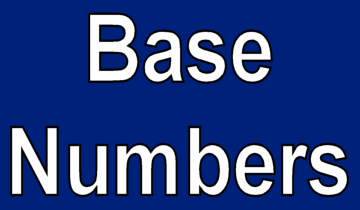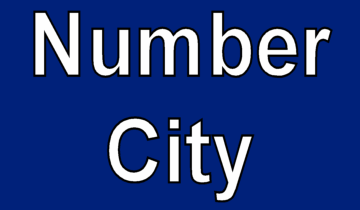 Home
DFS
SB
OD
SDN
DFSM
THP
Donate $5
Home
DFS
SB
OD
SDN
DFSM
THP
Donate $5
A radix, or base, is the number of unique digits including the digit zero that is used to represent a number base system. Examples: 0 and 1 represent the digits for the binary system; 0, 1, 2, 3, 4, 5, 6, 7, 8 and 9 represent the digits for the decimal system.
0 - nullary (it can represent just the value zero. Not a very useful base. There is just nothing. The radix would have no digits!)
1 - unary (it's basically a tally system with just one numeral such as a stick, rock, marble, the digit zero or whatever else that could be representing a digit, otherwise known as the base one system.)
2 - binary / dual (used internally by nearly all computers)
3 - ternary / trinary
4 - quaternary (2 x 2)
5 - quinary / quinternary
6 - senary / heximal / seximal (2 x 3)
7 - septenary / septimal
8 - octal / octonary / octimal (2 x 2 x 2)
9 - nonary / nonal (3 x 3)
From this point on, the two-digit number combinations in the base number names will be repeated every 100 names including the last two digits in the range of 100-109, which are not seen in the range of 0-9 (modified versions of the names of bases 0-9 begin with the range of bases 100-109.)
The decades and units portions of the names of the base names (the last two digits) are colored red. Those two red pairings will be repeated every 100 names
One update: except for unary and unarsimal, I made all of the particles that begin with un into uni so it flows better when you speak it. The alternate spellings are next to them.
10 - decimal / denary / biquinary (most widely used by modern civilizations) (2 x 5)
11 - unidecimal / undecimal / undenary / elevenary
12 - duodecimal / dozenal / duodenary / biseximal (2 x 6)
13 - tridecimal / tredecimal / tridenary / triskadecimal
14 - tetradecimal / quadrodecimal / quadadecimal / quattuordecimal / biseptenary / biseptimal (2 x 7)
15 - pentadecimal / quindecimal / triquinary (3 x 5)
16 - hexadecimal / hex / sedecimal / sexadecimal (widely used for compact notation of binary data) (4 x 4, 2 x 2 x 2 x 2)
17 - heptadecimal / septendecimal / suboptimal
18 - octodecimal / triseximal / binonary (2 x 9, 3 x 6)
19 - enneadecimal / nonadecimal / decennoval / untriseximal
20 - vigesimal (2 x 10, 4 x 5)
21 - univigesimal / unvigesimal / unovigesimal / triseptimal (3 x 7)
22 - duovigesimal / bielevenary (2 x 11)
23 - trivigesimal / triovigesimal / unbielevenary
24 - tetravigesimal / quadrovigesimal / tetraseximal (hours in a day) (4 x 6)
25 - pentavigesimal / pentaquinary (related to base 5) (5 x 5)
26 - hexavigesimal / sexavigesimal
27 - heptavigesimal / septemvigesimal / trinonary (3 x 3 x 3)
28 - octovigesimal / tetraseptimal (4 x 7)
29 - enneavigesimal / novovigesimal / nonavigesimal / untetraseptimal
30 - trigesimal / pentaseximal (5 x 6)
31 - unitrigesimal / untrigesimal / unotrigesimal / unpentaseximal
32 - duotrigesimal / tetroctal (4 x 8)
33 - tritrigesimal / trielevenary (3 x 11)
34 - tetratrigesimal / bisuboptimal (2 x 17)
35 - pentatrigesimal / pentaseptimal (5 x 7)
36 - hexatrigesimal / hexatridecimal / sexatrigesimal / niftimal (use of all letters with one case and digits, related to base 6) (6 x 6)
37 - heptatrigesimal
38 - octotrigesimal
39 - enneatrigesimal
40 - quadragesimal
41 - uniquadragesimal / unquadragesimal
42 - duoquadragesimal
43 - triquadragesimal
44 - tetraquadragesimal
45 - pentaquadragesimal
46 - hexaquadragesimal
47 - heptaquadragesimal
48 - octoquadragesimal
49 - enneaquadragesimal (related to base 7) (7 x 7)
50 - quinquagesimal
51 - uniquinquagesimal / unquinquagesimal
52 - duoquinquagesimal
53 - triquinquagesimal
54 - tetraquinquagesimal
55 - pentaquinquagesimal
56 - hexaquinquagesimal
57 - heptaquinquagesimal
58 - octoquinquagesimal
59 - enneaquinquagesimal
60 - sexagesimal / hexagesimal (seconds in a minute and minutes in an hour)
61 - unisexagesimal / unsexagesimal
62 - duosexagesimal (using both cases of all 26 letters plus the digits 0-9)
63 - trisexagesimal
64 - tetrasexagesimal / quadrosexagesimal (related to base 8)
65 - pentasexagesimal
66 - hexasexagesimal
67 - heptasexagesimal
68 - octosexagesimal
69 - enneasexagesimal
70 - septagesimal
71 - uniseptagesimal / unseptagesimal
72 - duoseptagesimal
73 - triseptagesimal
74 - tetraseptagesimal
75 - pentaseptagesimal
76 - hexaseptagesimal
77 - heptaseptagesimal
78 - octoseptagesimal
79 - enneaseptagesimal
80 - octogesimal
81 - unioctogesimal / unoctogesimal (related to base 9) (9 x 9)
82 - duoctogesimal
83 - trioctogesimal
84 - tetroctogesimal
85 - pentoctogesimal (not pentaoctogesimal)
86 - hexoctogesimal
87 - heptoctogesimal
88 - octooctogesimal
89 - enneoctogesimal
90 - nonagesimal / nonogesimal / novagesimal
91 - uninonagesimal / unnonagesimal
92 - duononagesimal
93 - trinonagesimal
94 - tetranonagesimal
95 - pentanonagesimal
96 - hexanonagesimal
97 - heptanonagesimal
98 - octononagesimal
99 - enneanonagesimal
With bases 100-199, all systems should start with the cente- particle. May be modified as needed for certain words. We begin the first 10 of this hundred by using modified names of the base 1-9 systems in the proposed names beginning with 101
To make it easier for reading the long names, I made the hundreds portion of the base dark red.
The decades and units portions of the long names (the last two digits) are colored red. Those two red pairings will be repeated every 100 names
100 - centesimal / centimal
101 - centeunarsimal (proposed)
102 - centebinarsimal (proposed)
103 - centeternarsimal (proposed)
104 - centequaternarsimal (proposed)
105 - centequinarsimal (proposed)
106 - centesenarsimal (proposed)
107 - centeseptensimal (proposed)
108 - centeoctasimal (proposed)
109 - centenonarsimal (proposed)
Here are some suggested alternatives to the range of 101-109:
101 - centeunisimal (proposed-alternative)
102 - centeduosimal (proposed-alternative)
103 - centetriosimal (proposed-alternative)
104 - centetetrasimal (proposed-alternative)
105 - centepentasimal (proposed-alternative)
106 - centehexasimal (proposed-alternative)
107 - centeheptasimal (proposed-alternative)
108 - centeoctosimal (proposed-alternative)
109 - centeenneasimal (proposed-alternative)
With bases 110-199, we simply add the cente- prefix to each of the 10-19 names.
110 - centedecimal (proposed)
111 - centeunidecimal (proposed)
112 - centeduodecimal (proposed)
113 - centetridecimal (proposed)
114 - centetetradecimal (proposed)
115 - centepentadecimal (proposed)
116 - centehexadecimal (proposed)
117 - centeheptadecimal (proposed)
118 - centeoctodecimal (proposed)
119 - centeenneadecimal (proposed)
120 - centevigesimal / centovigesimal
121 - centeunivigesimal (related to base 11) (11 x 11)
122 - centeduovigesimal (proposed)
123 - centetrivigesimal (proposed)
124 - centetetravigesimal (proposed)
125 - centepentavigesimal (related to base 5) (5 x 5 x 5)
126 - centehexavigesimal (proposed)
127 - centeheptavigesimal (proposed)
128 - centeoctovigesimal (related to base 2) (27)
129 - centeenneavigesimal (proposed)
130 - centetrigesimal (proposed)
131 - centeunitrigesimal (proposed)
132 - centeduotrigesimal (proposed)
133 - centetritrigesimal (proposed)
134 - centetetratrigesimal (proposed)
135 - centepentatrigesimal (proposed)
136 - centehexatrigesimal (proposed)
137 - centeheptatrigesimal (proposed)
138 - centeoctotrigesimal (proposed)
139 - centeenneatrigesimal (proposed)
140 - centequadragesimal (proposed)
141 - centeuniquadragesimal (proposed)
142 - centeduoquadragesimal (proposed)
143 - centetriquadragesimal (proposed)
144 - centetetraquadragesimal / centotetraquadragesimal (related to base 12) (12 x 12)
145 - centepentaquadragesimal (proposed)
146 - centehexaquadragesimal (proposed)
147 - centeheptaquadragesimal (proposed)
148 - centeoctoquadragesimal (proposed)
149 - centeenneaquadragesimal (proposed)
150 - centequinquagesimal (proposed)
151 - centeuniquinquagesimal (proposed)
152 - centeduoquinquagesimal (proposed)
153 - centetriquinquagesimal (proposed)
154 - centetetraquinquagesimal (proposed)
155 - centepentaquinquagesimal (proposed)
156 - centehexaquinquagesimal (proposed)
157 - centeheptaquinquagesimal (proposed)
158 - centeoctoquinquagesimal (proposed)
159 - centeenneaquinquagesimal (proposed)
160 - centesexagesimal (proposed)
161 - centeunisexagesimal (proposed)
162 - centeduosexagesimal (proposed)
163 - centetrisexagesimal (proposed)
164 - centetetrasexagesimal (proposed)
165 - centepentasexagesimal (proposed)
166 - centehexasexagesimal (proposed)
167 - centeheptasexagesimal (proposed)
168 - centeoctosexagesimal (proposed)
169 - centeenneasexagesimal (proposed) (13 x 13)
170 - centeseptagesimal (proposed)
171 - centeuniseptagesimal (proposed)
172 - centeduoseptagesimal (proposed)
173 - centetriseptagesimal (proposed)
174 - centetetraseptagesimal (proposed)
175 - centepentaseptagesimal (proposed)
176 - centehexaseptagesimal (proposed)
177 - centeheptaseptagesimal (proposed)
178 - centeoctoseptagesimal (proposed)
179 - centeenneaseptagesimal (proposed)
180 - centeoctogesimal (proposed)
181 - centeunioctogesimal (proposed)
182 - centeduoctogesimal (proposed)
183 - centetrioctogesimal (proposed)
184 - centetetroctogesimal (proposed)
185 - centepentoctogesimal (proposed)
186 - centehexoctogesimal (proposed)
187 - centeheptoctogesimal (proposed)
188 - centeoctooctogesimal (proposed)
189 - centeenneoctogesimal (proposed)
190 - centenonagesimal (proposed)
191 - centeuninonagesimal (proposed)
192 - centeduononagesimal (proposed)
193 - centetrinonagesimal (proposed)
194 - centetetranonagesimal (proposed)
195 - centepentanonagesimal (proposed)
196 - centehexanonagesimal (proposed) (related to base 14) (14 x 14)
197 - centeheptanonagesimal (proposed)
198 - centeoctononagesimal (proposed)
199 - centeenneanonagesimal (proposed)
For century particles 200s to 900s, just replace the cente with those below.
We begin the decentesimal century group of bases here.
200 - ducentesimal / duocentesimal / ducentimal / duocentimal
(...repeat naming pattern...)
225 - ducentepentavigesimal (proposed) (related to base 15) (15 x 15)
(...repeat naming pattern...)
240 - ducentequadragesimal (proposed) / duocentequadragesimal / duocentoquadragesimal
(...repeat naming pattern...)
256 - ducentehexaquinquagesimal / duocentehexaquinquagesimal (related to base 16) (16 x 16, 28)
(...repeat naming pattern...)
300 - trecentesimal / tercentesimal / tricentesimal / tercentimal
(...repeat naming pattern...)
360 - trecentesexagesimal / trecentosexagesimal(degrees for an angle)
(...repeat naming pattern...)
400 - quadringentesimal / quattrocentimal / quadricentesimal
(...repeat naming pattern...)
500 - quingentesimal / quincentimal / pentacentesimal
(...repeat naming pattern...)
600 - sescentesimal / hexacentimal / hexacentesimal
(...repeat naming pattern...)
700 - septingentesimal / heptacentimal / heptacentesimal
(...repeat naming pattern...)
800 - octingentesimal / octacentimal / octocentimal / octacentesimal / octocentesimal
(...repeat naming pattern...)
900 - noningentesimal / novacentimal / novacentesimal
(...repeat naming pattern...)
999 - noningenteenneanonagesimal (proposed)
Now we get to the thousand bases. Note that since we're at the millenium mark, there is nothing in the century column, so we just leave out the century part of the name and just use the thousand position and the decade/unit pairing as the base of naming. We color the thousand prefix green for easier reading.
Since it's one thousand, I used just the mille particle. I will use it only when the hundred-thousands and ten-thousands places are both zero. Alternatively, you can use the unimille particle to represent the same number.
When we get to the millions where there are all zeros in the thousands, ten-thousands and hundred-thousands positions of the numbers, I'll just leave out the mille particle. No sense of taking up more space and making words harder to pronounce.
1,000 - millesimal (10 x 10 x 10)
This one is difficult. In case hundreds of years from now somebody has a use for base 1001, here's my solution to the naming of that base. Note that since the hundreds (century) column is zero, we skip the particle related to its position and name it like this:
1,001 - milleunarsimal (proposed)
(...repeat naming pattern...)
For 1,010 and 1,011, they go like this:
1,010 - milledecimal (proposed)
1,011 - milleunidecimal (proposed)
(...repeat naming pattern...)
We get to the 1100 mark, and this time, we use the century part of the name since there is at least a non-zero digit in the hundreds position.
1,100 - millecentesimal (proposed)
The next one after that looks like this:
1,101 - millecenteunarsimal (proposed)
(...repeat naming pattern...)
We're at 1110 where there is a non-zero number in the base. It looks like this, using the red pairing seen in the base numbers ending in "10"
1,110 - millecentedecimal (proposed)
And for the base after that, this one is easy to figure out.
1,111 - millecenteunidecimal (proposed)
(...repeat naming pattern...)
1,200 - milleducentesimal (proposed)
(...repeat naming pattern...)
2,000 - bimillesimal (proposed)
(...repeat naming pattern...)
3,000 - trimillesimal (proposed)
(...repeat naming pattern...)
4,000 - quaternmillesimal (proposed)
(...repeat naming pattern...)
5,000 - quinarmillesimal (proposed)
(...repeat naming pattern...)
6,000 - senarmillesimal (proposed)
(...repeat naming pattern...)
7,000 - septenmillesimal (proposed)
(...repeat naming pattern...)
8,000 - octamillesimal (proposed)
(...repeat naming pattern...)
9,000 - nonamillesimal (proposed)
(...repeat naming pattern...)
10,000 - decimillesimal (10 x 10 x 10 x 10) (100 x 100)
(...repeat naming pattern...)
11,000 - unidecimillesimal (proposed)
(...repeat naming pattern...)
20,000 - vigesmillesimal (proposed)
(...repeat naming pattern...)
65,000 - pentasexagemillesimal (proposed)
(...repeat naming pattern...)
65,536 - pentasexagemillequingentehexatrigesimal (proposed) (216, 2562, used for 16-bit words or two 8-bit bytes)
(...repeat naming pattern...)
REVISION: Beginning with the ten-thousands, I will use the hundred particles in darker green. In this case where the thousands and ten-thousands are both zeroes, and the fact that there is a non-zero in the hundred-thousands column, I will use the mille particle after the hundred particle to describe the thousands portion of the name of the base number. (ex: 100, 200, 300...900)
In the case where there's a non-zero in the hundred-thouesands, a zero in the ten-thousands, and a one in the thousands, I'll use the unimille particle. (ex: 101, 201, 301,...901.)
So my rule for using the mille- particle grouping goes like this: I'll use it only if at least one of the three positions, thousands, ten-thousands and hundred-thousands, are non-zero. Else, it's left out of the name altogether.
Furthermore, for describing the nonzero hundred-thousands positions of the base number name, you use at least one of the hundred particles along with the other particles for thousands and ten-thousands.
So with that, here goes...
100,000 - centesmillesimal (proposed) (10 x 10 x 10 x 10 x 10 x 10)
(...repeat naming pattern...)
101,000 - centesunimillesimal (proposed)
(...repeat naming pattern...)
110,000 - centesdecimillesimal (proposed)
(...repeat naming pattern...)
111,000 - centesunidecimillesimal (proposed)
(...repeat naming pattern...)
999,999 - noningentesenneanonagesmillenoningenteenneanonagesimal (proposed)
106 - micresimal
(...repeat naming pattern if you really care...)
109 - nanesimal
1012 - pikesimal
1015 - femtesimal
1018 - attesimal
1021 - zeptesimal
1024 - yoctesimal
Personally, I don't yet see why anyone would need bases in the milions and beyond but we never know what use it would provide to mathematicians and scientists hundreds and thousands of years from since I wrote this in the year 2020.
© 1995-2026. davesfunstuff.com. All Rights Reserved. Reproduction of any part of this website without expressed written consent is prohibited.



